Double Height DDR4: 32GB Modules from G.Skill and ZADAK Reviewed
by Ian Cutress & Gavin Bonshor on January 23, 2019 9:00 AM ESTCPU Performance, Short Form
For our motherboard reviews, we use our short form testing method. These tests usually focus on if a motherboard is using MultiCore Turbo (the feature used to have maximum turbo on at all times, giving a frequency advantage), or if there are slight gains to be had from tweaking the firmware. We put the memory settings at the CPU manufacturers suggested frequency, making it very easy to see which motherboards have MCT enabled by default.
Handbrake 1.1.0: Streaming and Archival Video Transcoding
A popular open source tool, Handbrake is the anything-to-anything video conversion software that a number of people use as a reference point. The danger is always on version numbers and optimization, for example the latest versions of the software can take advantage of AVX-512 and OpenCL to accelerate certain types of transcoding and algorithms. The version we use here is a pure CPU play, with common transcoding variations.
We have split Handbrake up into several tests, using a Logitech C920 1080p60 native webcam recording (essentially a streamer recording), and convert them into two types of streaming formats and one for archival. The output settings used are:
- 720p60 at 6000 kbps constant bit rate, fast setting, high profile
- 1080p60 at 3500 kbps constant bit rate, faster setting, main profile
- 1080p60 HEVC at 3500 kbps variable bit rate, fast setting, main profile
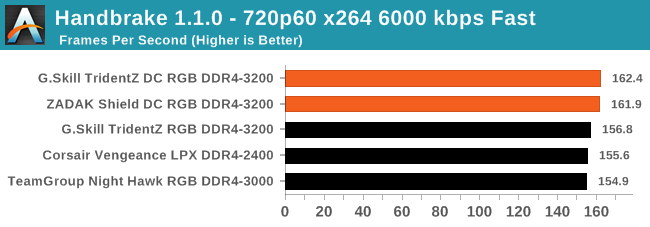


In Handbrake both the G.Skill TridentZ RGB DC and ZADAK Shield RGB DC memory show a noticable benefit. The results are beyond the margin of error associated as well as both kits performing very similar across all three formats.
Blender 2.79b: 3D Creation Suite
A high profile rendering tool, Blender is open-source allowing for massive amounts of configurability, and is used by a number of high-profile animation studios worldwide. The organization recently released a Blender benchmark package, a couple of weeks after we had narrowed our Blender test for our new suite, however their test can take over an hour. For our results, we run one of the sub-tests in that suite through the command line - a standard ‘bmw27’ scene in CPU only mode, and measure the time to complete the render.
Blender can be downloaded at https://www.blender.org/download/
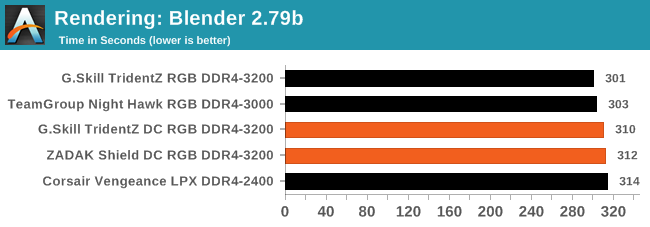
The extra capacity and design proves ineffective within Blender and actually performs similar to other normal capacity kits at similar frequencies.
Rendering - Cinebench R15: link
Cinebench is a benchmark based around Cinema 4D, and is fairly well known among enthusiasts for stressing the CPU for a provided workload. Results are given as a score, where higher is better. The benchmark was created by MAXON and integrates workloads suitable for applications such as graphic design, VFX, game development and render engines. The testing is split into single thread and multi-threaded performance and is primarily a CPU and graphics benchmark.
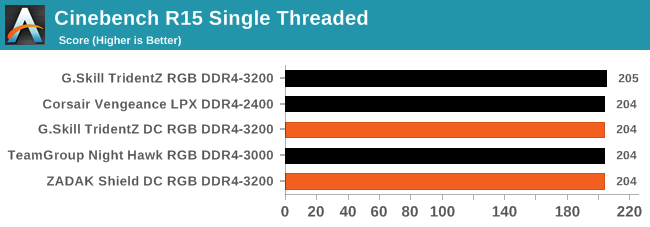
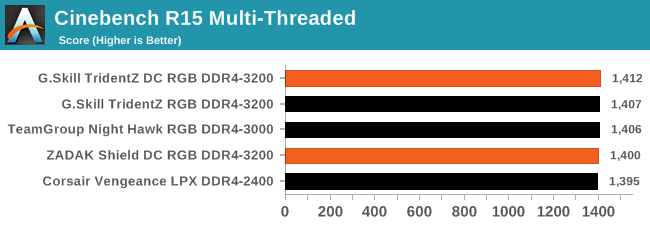
Performance in Cinebench R15 proved similar to other kits on test with the G.Skill TridentZ RGB DC DDR4-3200 proving the best of the pack in the multi-threaded test due to sub-timings.
POV-Ray 3.7.1: Ray Tracing
The Persistence of Vision ray tracing engine is another well-known benchmarking tool, which was in a state of relative hibernation until AMD released its Zen processors, to which suddenly both Intel and AMD were submitting code to the main branch of the open source project. For our test, we use the built-in benchmark for all-cores, called from the command line.
POV-Ray can be downloaded from http://www.povray.org/
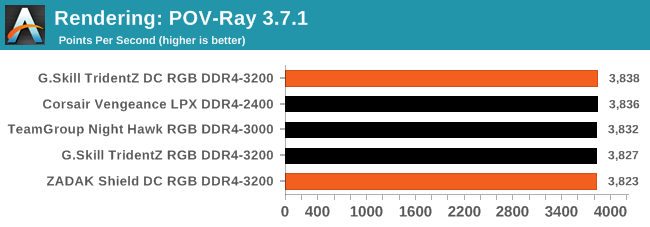
POV-Ray performance is essentially the same in this test.
WinRAR 5.60b3: Archiving Tool
My compression tool of choice is often WinRAR, having been one of the first tools a number of my generation used over two decades ago. The interface has not changed much, although the integration with Windows right click commands is always a plus. It has no in-built test, so we run a compression over a set directory containing over thirty 60-second video files and 2000 small web-based files at a normal compression rate.
WinRAR is variable threaded but also susceptible to caching, so in our test we run it 10 times and take the average of the last five, leaving the test purely for raw CPU compute performance.
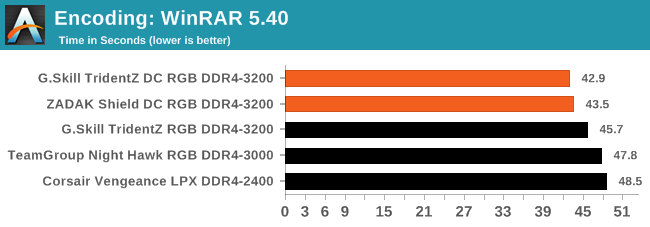
WinRAR is one of the more memory sensitive benchmarks and encoding can gain from having higher performance memory installed. Both kits of DC memory show benefit here and outperform the standard kits consistently.
7-zip v1805: Popular Open-Source Encoding Engine
Out of our compression/decompression tool tests, 7-zip is the most requested and comes with a built-in benchmark. For our test suite, we’ve pulled the latest version of the software and we run the benchmark from the command line, reporting the compression, decompression, and a combined score.
It is noted in this benchmark that the latest multi-die processors have very bi-modal performance between compression and decompression, performing well in one and badly in the other. There are also discussions around how the Windows Scheduler is implementing every thread. As we get more results, it will be interesting to see how this plays out.
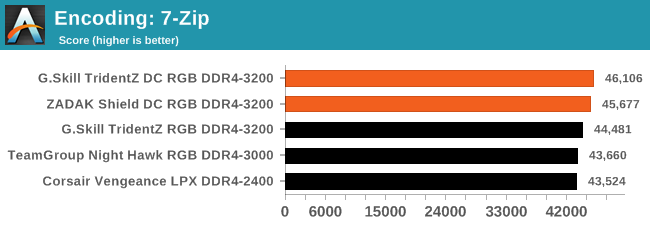
The DC memory also displays consistently better performance over standard capacity memory in 7-Zip.
3D Particle Movement v2.1: Brownian Motion
Our 3DPM test is a custom built benchmark designed to simulate six different particle movement algorithms of points in a 3D space. The algorithms were developed as part of my PhD., and while ultimately perform best on a GPU, provide a good idea on how instruction streams are interpreted by different microarchitectures.
A key part of the algorithms is the random number generation – we use relatively fast generation which ends up implementing dependency chains in the code. The upgrade over the naïve first version of this code solved for false sharing in the caches, a major bottleneck. We are also looking at AVX2 and AVX512 versions of this benchmark for future reviews.
For this test, we run a stock particle set over the six algorithms for 20 seconds apiece, with 10 second pauses, and report the total rate of particle movement, in millions of operations (movements) per second. We use a non-AVX version here.
3DPM v2.1 can be downloaded from our server: 3DPMv2.1.rar (13.0 MB)
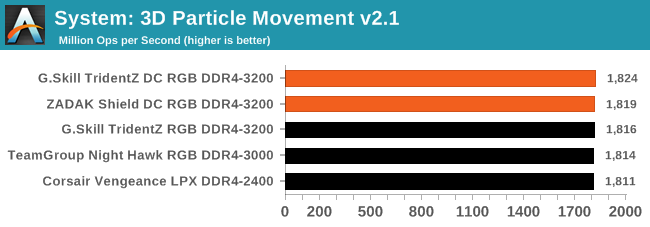
Results in our 3DPM benchmark are all within a percent from top to bottom and there isn't much benefit.
DigiCortex 1.20: Sea Slug Brain Simulation
This benchmark was originally designed for simulation and visualization of neuron and synapse activity, as is commonly found in the brain. The software comes with a variety of benchmark modes, and we take the small benchmark which runs a 32k neuron / 1.8B synapse simulation, equivalent to a Sea Slug.

Example of a 2.1B neuron simulation
We report the results as the ability to simulate the data as a fraction of real-time, so anything above a ‘one’ is suitable for real-time work. Out of the two modes, a ‘non-firing’ mode which is DRAM heavy and a ‘firing’ mode which has CPU work, we choose the latter. Despite this, the benchmark is still affected by DRAM speed a fair amount.
DigiCortex can be downloaded from http://www.digicortex.net/
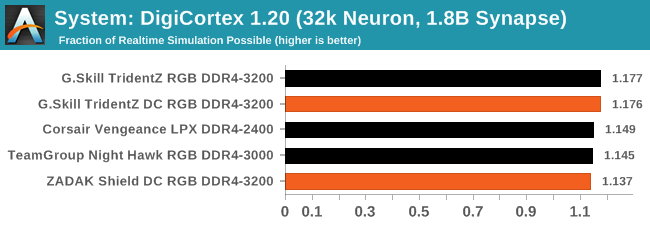
Similarly, there is no real benefit to the new memory. The G.Skill is higher than the ZADAK again however.










50 Comments
View All Comments
mickulty - Wednesday, January 23, 2019 - link
Really interesting article, thanks Gav and Ian!I'd love to see how a configuration using these DC sticks compares to 4x16GB on a 4-dimm T-topology board, especially in ability to hit higher speeds.
edzieba - Wednesday, January 23, 2019 - link
Presumably the "Two DIMMs One Channel"-on-a-board layout would preclude these being used in 4-slot consumer boards (which would require effectively 4 DIMMs per channel)? I can't think of any boards off the top of my head that support more than 2 DIMMs per channel without using FBDIMMs.Ej24 - Wednesday, January 23, 2019 - link
Intel has validated their 8th and 9th gen desktop cpu's to work with 128gb of memory so that would suggest its possible, it's just up to the motherboard manufacturer to implement it appropriately.Hul8 - Wednesday, January 23, 2019 - link
I believe that's using regular (not double) modules with 16x Samsung's new 16 Gb memory packages. You can still use 2 of those per channel on regular consumer motherboards.Ej24 - Wednesday, January 23, 2019 - link
https://www.anandtech.com/show/13473/intel-to-supp...schujj07 - Wednesday, January 23, 2019 - link
I wonder if something that this could be designed for servers using RDIMMS or LRDIMMS. Current cost of 64GB LRDIMMs is more than double that of 32GB RDIMMs. 128GB LRDIMMs are about 4x more expensive than 64GB LRDIMMs. Could be a nice way to increase RAM capacity there without breaking the bank.brakdoo - Wednesday, January 23, 2019 - link
128 GB and 256 GB DIMMs use TSV (sometimes called 3DS or 3D stacked in the server business) memory. That's why they are more expensive.Other than that: This approach doubles the rank. Typical servers already reach their "maximum rank" on each channel with regular sized memory.
mickulty - Wednesday, January 23, 2019 - link
It's pretty common for various forms of registered/buffered memory to use x4 width ICs rather than the standard x8, meaning you have 16 per rank rath than 8 per rank with the same capacity per IC. That acheives the same thing in terms of capacity.nathanddrews - Wednesday, January 23, 2019 - link
Certainly looks like the future of RAM, but like most things, I would wait for v3.0 before jumping in. There's bound to be more power savings, compatibility tweaks, and performance tweaks. When is DDR5 arriving?oddity1234 - Wednesday, January 23, 2019 - link
That's a bizarre existential predicament the sea slug is stuck in.